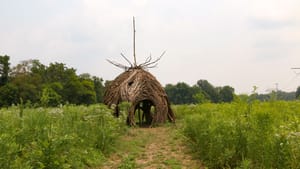Stay in the Loop
BSR publishes on a weekly schedule, with an email newsletter every Wednesday and Thursday morning. There’s no paywall, and subscribing is always free.
Nature’s engineering
The Brandywine River Museum of Art presents Ian Stabler’s Queen Anne’s Lace Pod

For the past several seasons, the Brandywine River Museum of Art has commissioned site-specific artworks on its grounds. The latest is a rustic yet eloquent sheltering sculpture by Virginia artist Ian Stabler, sited in a field along the historic Pennsylvania river.
Approached on a mown path meandering through Pott’s Meadow, Queen Anne’s Lace Pod is a 15-minute walk from the museum’s parking lot. Crossing Route 100 and seeking the sculpture, you follow a marked path meandering through the fields that crosses the Brandywine River, bucolic acreage filled with wildflowers and buzzing with insects. When the domed structure rises on the horizon, it’s surprisingly welcome and uplifting, a sign of life in the woods.
The subtleties of the meadow
Stabler created this work as a response to the site’s terrain. The artist grew up in New York but has been a frequent visitor to the Brandywine Valley, artistic terroir that remains a consistent inspiration. His direct reference for this work was a painting Stabler has always loved: August by George “Frolic” Weymouth (1936-2016). On view in the museum, Weymouth’s work depicts a field of Queen Anne’s Lace in bloom. Stabler turned the domed shape of this meadow plant’s seed pod upside down, building a 17-foot-tall structure whose roots extend to the sky.
Made entirely of found wood that was used as discovered (nothing was bent or shaped), Queen Anne’s Lace Pod took the artist and a cadre of volunteers more than a month to construct in situ. Each piece of wood, sourced one stick at a time, can be studied for its natural form, and Stabler noted that the building evolved with the shapes of the branches and limbs.
Taking something small and making it big allowed him to study what he calls “nature’s engineering,” noting that this structure was “a teacher in the subtleties of the meadow.”
The structure is intended to be viewed in two ways: seen sitting on the landscape and also experienced from the inside looking out. There are several entrances (one low to the ground is especially fun for children) and a small bench inside.
Simple, complex, and magical
On the hot summer day when I visited, it was a shady and surprisingly cool respite. A dozen or so openings invited a cooling cross-breeze, framing meadow and sky in miniature portraits of waving wildflowers, insects flitting by, and clouds in motion, reminiscent of works by James Turrell, an artist Stabler admires.
But bucolic as the scene might first appear, the human hand is omnipresent. Traffic zips along on nearby Route 1, and the poles and wires of high-voltage electric lines make a 21st-century comment on the rusticity of this structure. Stabler chose the site in part for this very dichotomy. In an artist walk-and-talk, he spoke about the need to connect to a place in order to care for it, creating this structure as “an invitation to pay attention to and revel in the beauty of our plants.”
Though it might look fragile from afar, the biomorphic structure is actually very sturdy. Stabler is also a trained builder, and his dome is shaped around a stable tripod frame (three beams set into the earth) and anchored with a center pole, the trunk of a fallen beech tree. The woven wood was attached by more than 1500 screws and rebar ties—almost impossible to see unless you hunt for them—that are acquiring a patina from their exposure to the elements.
Queen Anne’s Lace Pod might appear simple, but the more you look and think, the more complex and magical it becomes. It seems ancient, of another age; yet there are otherworldly sci-fi overtones. It carries echoes of a frontier log cabin but sits in a busy corridor. And it vibrates with both humor and serious artistic resonance. The moving work, imbued with the artist’s love of this land, may become a more permanent piece, but for now it’s scheduled to be only in Chadds Ford—standing out in its field—until early November. The artist likes to experience it at sunset, but it’s ready to invigorate and inspire whatever the time or weather.
What, When, Where
Queen Anne’s Lace Pod. By Ian Stabler. Through November 7, 2021, at Brandywine River Museum of Art, 1 Hoffman’s Mill Rd., Chadds Ford, PA. 610-388-2700 or brandywine.org.
Visitors do not need to enter the museum to view the work, which requires a 15-minute walk over natural flat unpaved terrain. Entry is at Potts Meadow on Route 100 in Chadds Ford. Follow directional signage. A map is available online.
The museum follows CDC and PA Department of Health guidelines. Indoors, masks are strongly encouraged and are available at the visitors’ desk.
Accessibility
The entire museum (including the café) is wheelchair accessible, with accessible parking, a barrier-free entrance, and wheelchairs available for visitors to borrow.
Sign up for our newsletter
All of the week's new articles, all in one place. Sign up for the free weekly BSR newsletters, and don't miss a conversation.

 Gail Obenreder
Gail Obenreder